I am so excited to share my delightfully spongy rasgulla recipe (also known as rosogolla, roshogollah or rasbari ) with you today. This popular Bengali dessert is beloved across the South Asian diaspora! Soft round dumplings made from chenna (an Indian cottage cheese) and semolina flour are simmered in a cardamom and rosewater scented sugar syrup for a tasty sweet that is simply lovely.

About Rasgulla
While the origin story of this treat is hotly contested in some circles, I know rasgulla to be a famous Bengali sweet made from milk.
To make rasgulla recipe, milk is curdled and drained of whey to make chenna, which is essentially a fresh cottage cheese.
The chenna is then kneaded with some semolina(rava or suji) or all purpose flour (maida). Round balls are made from the kneaded chenna, which are then cooked in sugar syrup.
The final touch is to scent the syrup with either aromatic cardamom or rosewater. The end result of this process is a pot full of sweet, syrupy cheese dumplings that are downright addictive.
About This Recipe
Rasgulla is our favorite Bengali sweet. It is also one of those few recipes for which I have received a shocking amount of requests. Although making rasgulla can be tricky, this post will help you to get it right.
After much trial and error, I have found that this method will result in the juiciest, spongiest dumplings! They’re so soft that they spring right back when you touch them. YUM!
In this rasgulla recipe post, I offer many tips and suggestions wherever possible so that you can easily make this tasty milk dessert at home.
These round white beauties stay good for a week in the refrigerator, so they are an excellent recipe for those of you who like to plan ahead.
Serve them plain as a simple sweet, or make Rasmalai with them. This recipe yields 18 to 20 rasgulla.
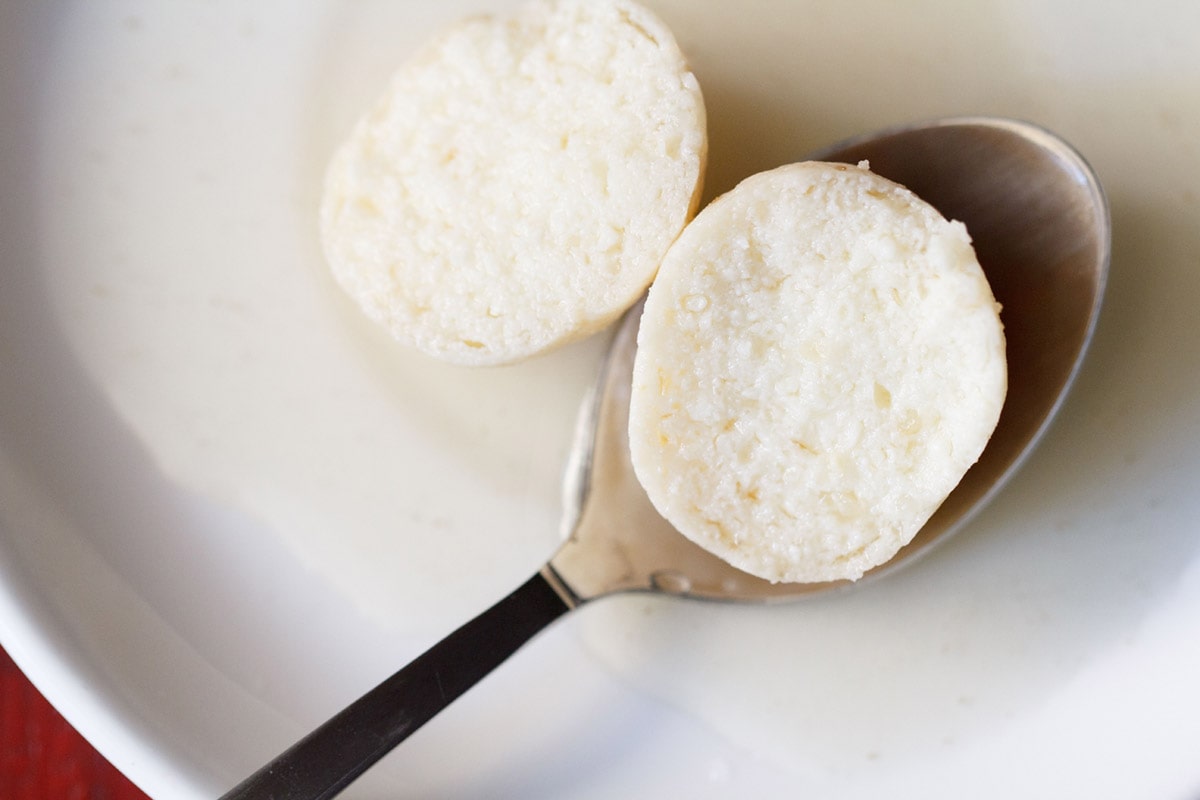
How to Make Rasgulla
While this recipe isn’t particularly difficult, there are quite a few steps involved. I have divided the rasgulla recipe into four parts for ease of reading:
- Making chenna
- Making rasgulla balls
- Preparing sugar syrup
- Cooking rasgulla
On a side note, I kneaded the chenna and cooked the sugar syrup simultaneously to save time. You can opt to prepare the chenna balls first and then make the sugar syrup if you are feeling overwhelmed.
Make Chenna
1. Take 1 litre of whole milk in a pan and bring it to a low boil on a low to medium heat.
NOTE: I used organic cow’s milk, which does not have much fat. If you use buffalo milk, it has too much of fat and makes for a thick layer of malai/cream floating on top. You have to remove the thick layer of malai before you proceed with the making of chenna.
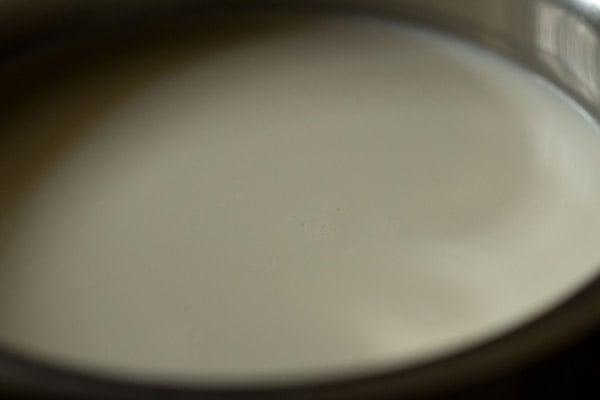
2. While the milk is heating up, line a mesh strainer or colander with a piece of cheese cloth or muslin.

3. Keep stirring the milk at intervals. This will help to prevent froth from forming on top and the base from scorching.
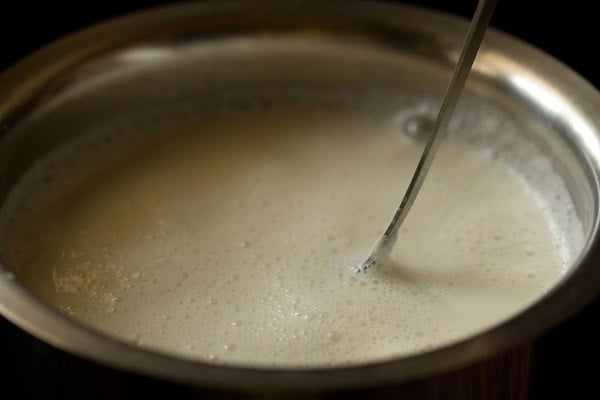
4. When the milk comes to a boil, then reduce the heat to its lowest. Add 1 to 3 tablespoons of lemon juice.
Start with just 1 tablespoon of lemon juice and stir very well. If the milk has not curdled completely, then add more. Keep the lemon juice handy so you can add it as needed.
NOTE: Depending on the quality of milk, you may need extra acid to get the milk to curdle. Vinegar also can be added instead of lemon juice. Another option is curd/yogurt. Add 4 to 5 tbsp of yogurt (or more if required).

5. As soon as the milk curdles, switch off the heat. The milk should curdle completely and you should see a green watery whey.
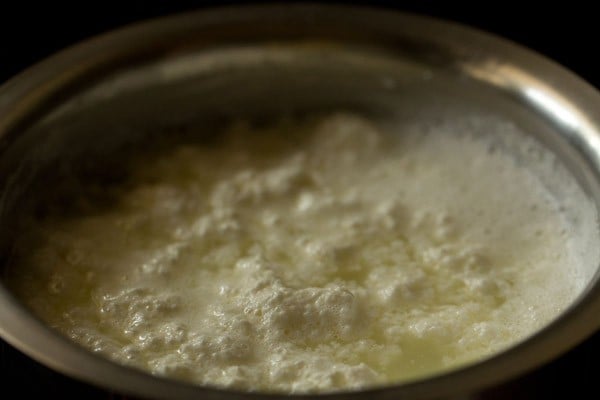
6. Now pour the curdled milk in the cheese cloth/muslin lined strainer or bowl.
TIP: The whey is very nutritious, so don’t discard it! Add it to your chapati dough or in dals or curries.
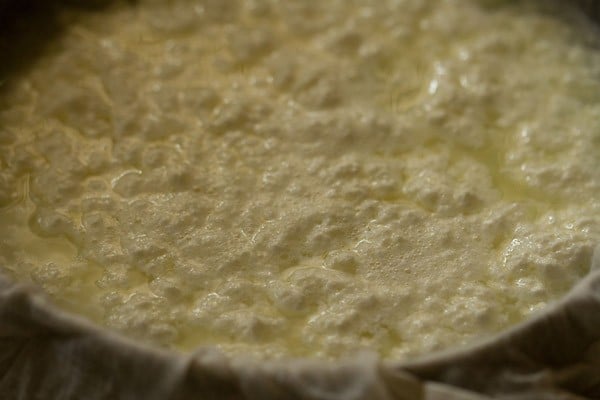
7. Gather the muslin from the sides and rinse the chenna or coagulated milk solids very well in running water. This brings down the temperature of chenna as well as removes the lemony flavor and tangy taste from the chenna.
NOTE: If you used yogurt/curd in place of the lemon, you don’t need to rinse the chenna in water.
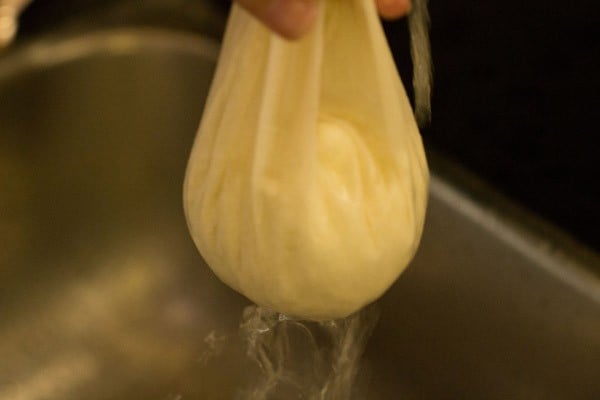
8. Now squeeze the muslin with your hands very well so that excess water is drained from the chenna.
Any excess moisture in the chenna will cause the rasgulla to break when cooking.

9. Place a heavy weight on the chenna for 7 to 8 minutes, or hang it for about 30 minutes.
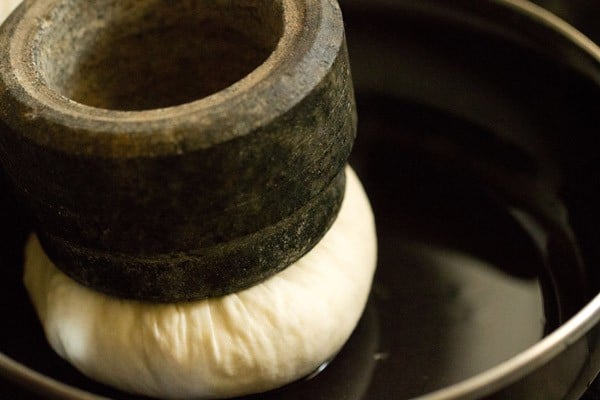
10. After the chenna is thoroughly drained, remove the cheesecloth. Think of chenna like Goldilocks – it should not have too much moisture nor be too dry. The texture below is just right!
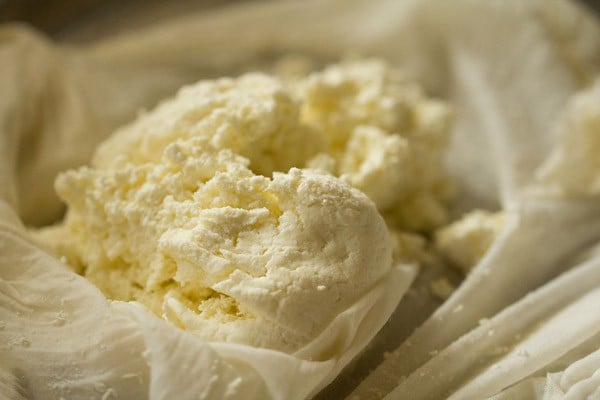
Make Rasgulla Balls
11. Add 1 teaspoon unroasted sooji, rava or semolina. The rava I had was coarse, but a finer one will also work well.
NOTE: You can substitute all purpose flour/maida to bind the dough. For a gluten-free option, add 1 teaspoon cornstarch instead of semolina or all purpose flour.
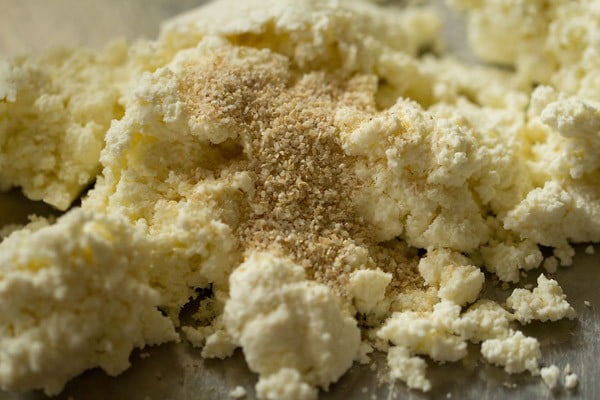
12. First mix the sooji with chenna and then begin to knead.
If you see that the chenna is watery, then you have a bit too much water. You can add some maida (all purpose flour) so that extra moisture is absorbed. Alternatively, keep a heavy weight on the chenna again so that the extra water or whey gets drained.
If the chenna looks crumbly and dry, then this means that you need some more moisture. To correct this, sprinkle 1 to 2 teaspoons of water while kneading.
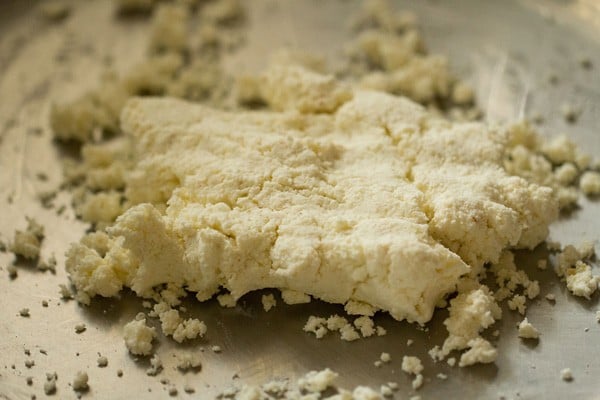
13. With the heels of your palms, mash the chenna and knead. Keep on collecting the chenna from the sides and continue to mash and knead.
This kneading process is very important and also decides the texture of chenna. When you feel your palms becoming a bit greasy, it is time to stop.
Just a bit of greasiness is required. Avoid kneading to an extent where the whole chenna becomes greasy.
I kneaded for about 10 minutes as I have very light hands. Depending on the quality of chenna and the pressure you apply while kneading, you can take more or less time.

14. Knead to a smooth ball of chenna which should be able to come together without breaking or falling apart.

15. A close up photo showing you the texture of the chenna dough.
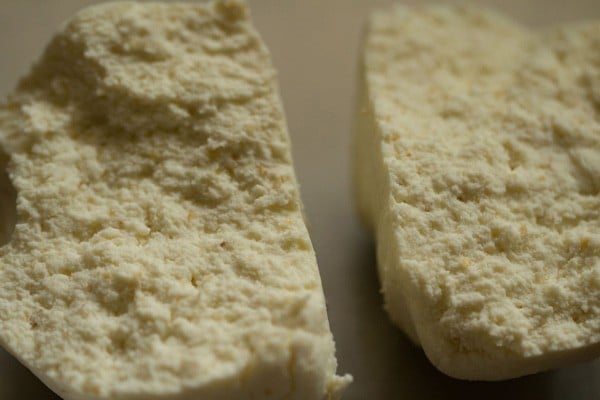
16. Now pinch small portions from the chenna and roll them between your palms to a smooth round ball.

17. Prepare all small balls this way. There will be some fine cracks on the chenna balls. Don’t worry! This is normal.

18. Cover all the chenna balls with a moist muslin or kitchen towel and keep aside.
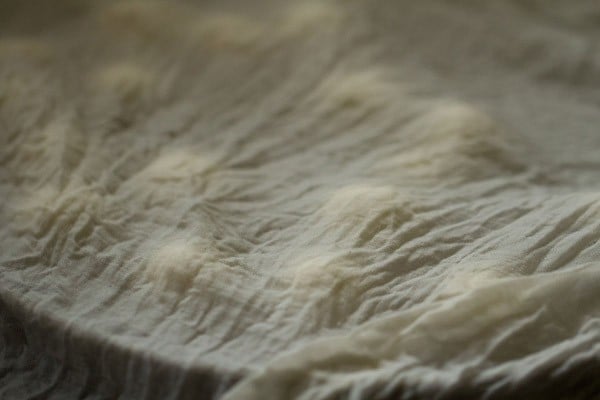
Make Sugar Syrup
19. In a large pot, take 2 cups sugar.

20. Add 4 cups water (1 litre). Be sure to use a large pot or pan so that there is enough space for the rasgulla to cook and increase in size. You can also use a stovetop pressure cooker.
I used a pot measuring 8.5 inches in diameter and 4.5 inches in height, roughly 3.5 litres.
NOTE: I used organic raw sugar, hence the golden tones to it. White sugar will also work just fine.

21. Heat the sugar solution on the stovetop over medium heat, stirring so the sugar dissolves. You don’t need to boil the solution.
If there are impurities in the sugar solution, then move to the next step. If no impurities, then move to Step 25.
NOTE: To save time, I kneaded the chenna and cooked the sugar syrup simultaneously.
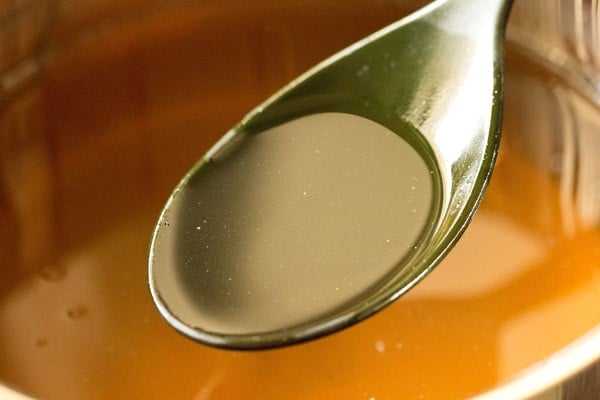
22. Add 1 tablespoon of milk and stir. Adding milk helps in removing impurities. If there are no impurities, then you don’t need to add milk and may directly proceed to step 25.
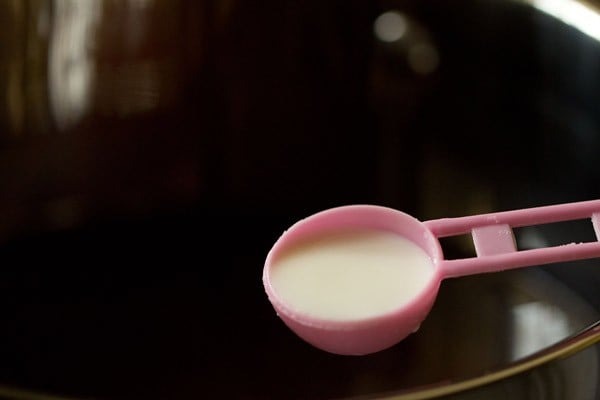
23. Once the sugar solution becomes hot, the impurities begin to float on the top.

24. You can either remove them with a spoon…
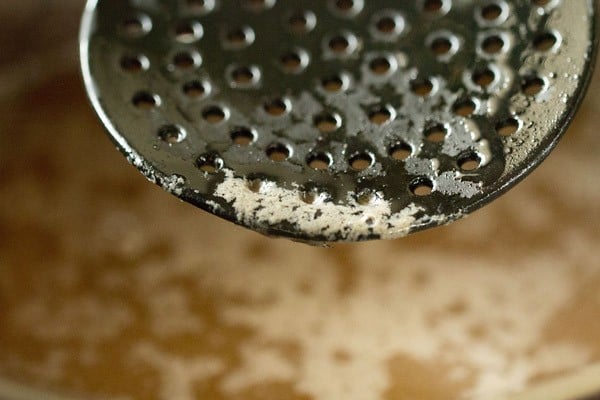
24. Or choose to strain the impurities in a cheese cloth/muslin lined strainer. I prefer this method.

25. Reserve ½ cup of sugar solution to add later while cooking the rasgulla.
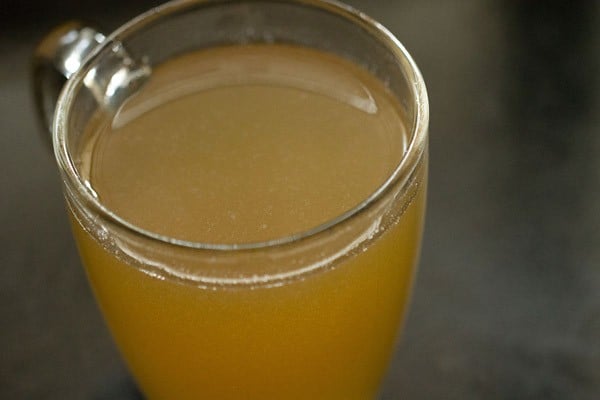
26. Reserve another 1 cup of the filtered sugar solution in a serving bowl.

27. Add the rest of the sugar solution (approximately 2.5 cups) back to the same large pot and bring it to a boil on a medium high heat.
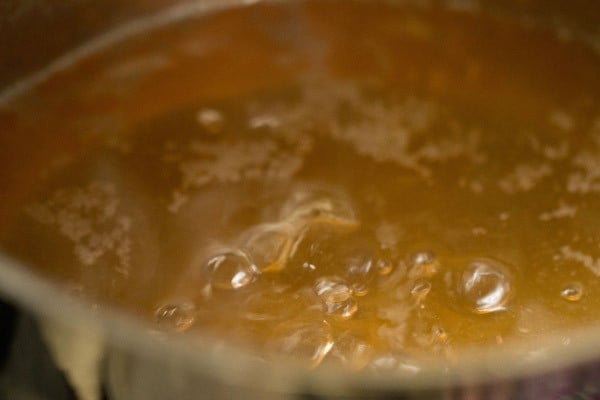
Cook Rasgulla
28. Gently slide the rasgulla balls into the sugar solution.
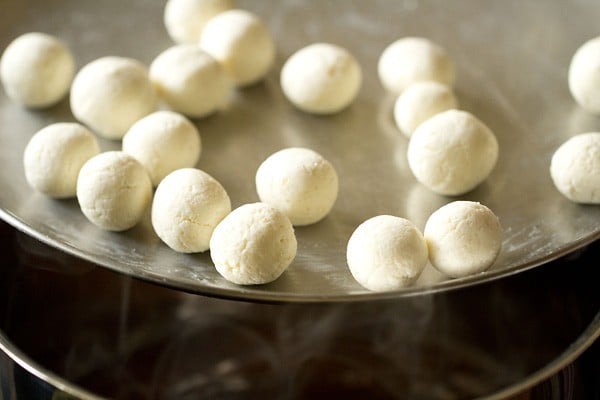
29. Once all the rasgulla have been added to the sugar solution, gently shake the pot. Don’t stir the rasgulla with a spoon.
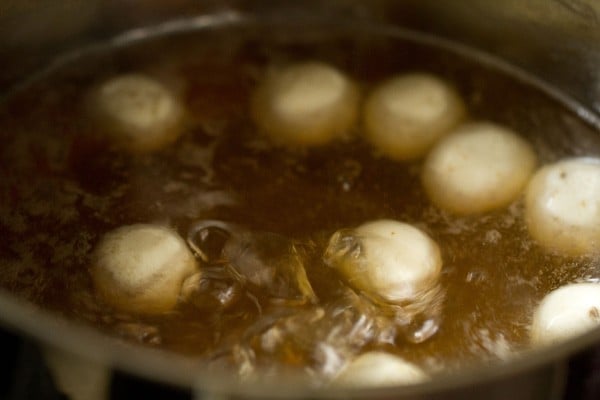
30. Cover immediately with a lid and let them cook. Keep the heat to a medium or medium high.

31. After 4 minutes, open the lid and add ¼ cup of the reserved sugar solution. Shake the pot.
Adding the reserved sugar solution ensures that the temperature and consistency of the sugar solution is maintained and the sugar does not cook to thread stage.
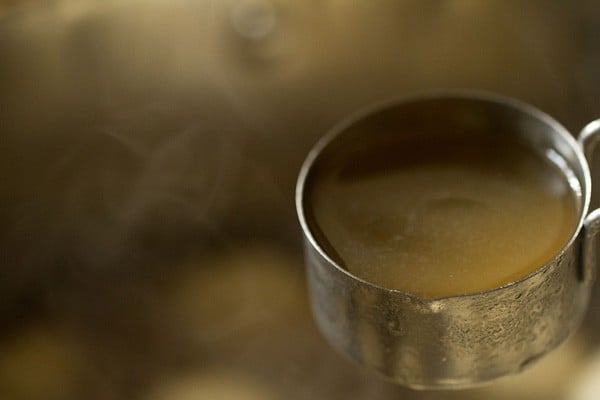
32. Cover again and continue to cook.
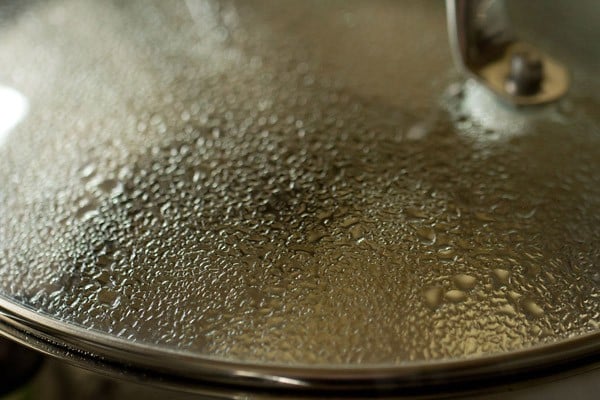
33. After 4 minutes, again add ¼ cup of the reserved sugar solution. Cover and again cook for 2 minutes.
In total, the rasgulla balls cooked for about 10 minutes. After 10 minutes, they had increased in size and were done.
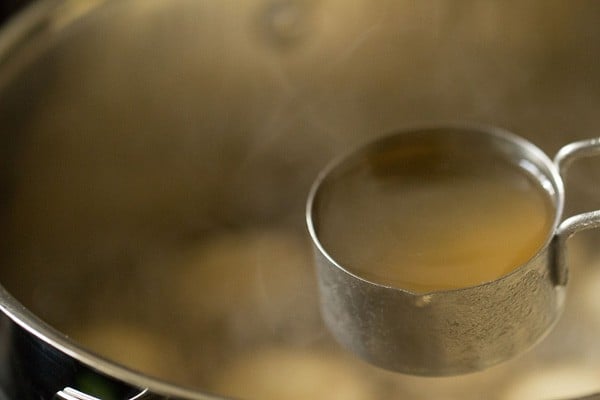
How to Know When Rasgulla Are Done
34. You have to check the doneness while the rasgulla are simmering. Once the rasgulla are cooked through, switch off the heat and keep the pot down.
The time to cook rasgulla will vary depending on the thickness and quality of pot; the size of pot; and the intensity of the heat.
The time range can be somewhere between 7 to 11 minutes. So you can add the ¼ cup sugar syrup after 2 to 3 minutes also instead of 4 minutes.
I used a thick bottomed wide and deep pot, so the cooking time was slightly more for me.
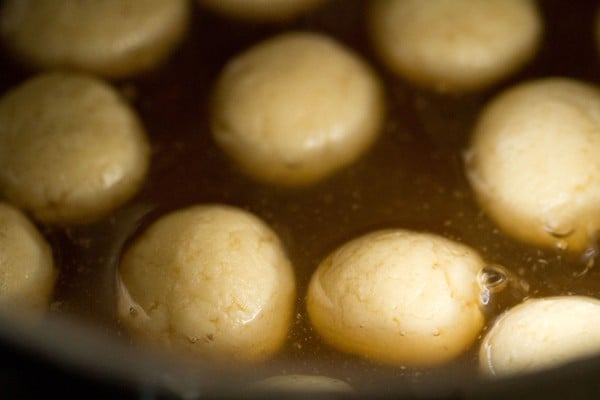
35. There are two ways to check the doneness of rasgulla.
- First method is to place the rasgulla in a bowl or cup of water. If the rasgulla sinks to the bottom and stays there, its cooked.
- Second method is to press a small portion of the rasgulla with your finger. If the pressed portion bounces back to its original shape, its done.

Soaking Rasgulla in Sugar Syrup
36. Once they are cooked, take each rasgulla with a spoon.
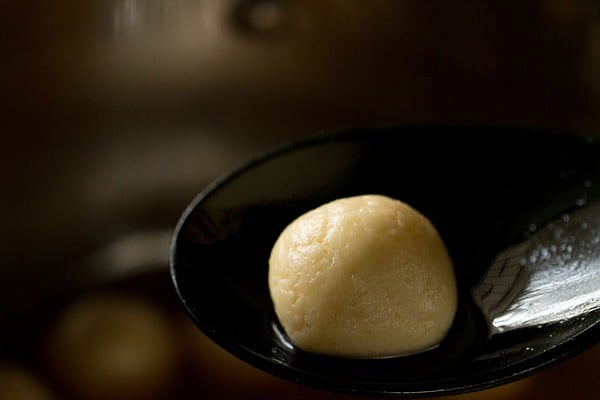
37. Place it in the serving bowl containing the reserved 1 cup of sugar solution. Cover and keep aside.

38. Let the sugar solution in which the rasgulla were cooked cool to a warm temperature. Then add this sugar solution to the serving bowl containing the rasgulla.
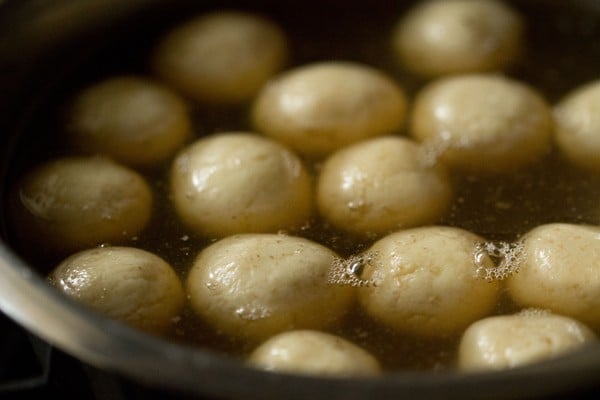
39. Once the whole mixture has cooled down, add 1 to 2 tablespoons of rosewater. Stir gently. Allow them to soak in the syrup for about 30 minutes, so that the flavors infuse the rasgulla.
TIP: Some flavoring has to be added, otherwise you will get a milky taste in the rasgulla. In case the milky taste is there, then you can increase the amount of rosewater or add 1 teaspoon cardamom powder.
NOTE: If you don’t have rose water you can substitute kewra water (pandanus water) or ½ teaspoon cardamom powder. You can even use both rosewater and cardamom powder.
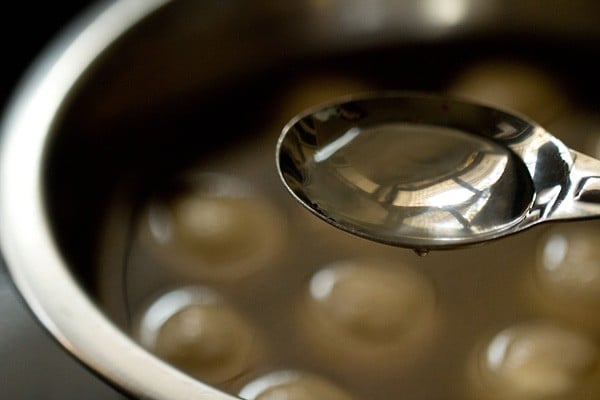
Storage and Serving Suggestions
40. You can serve the rasgulla now or refrigerate them and serve later cold. Keep them covered in an air-tight container. Rasgulla keeps well for about a week in the refrigerator. Do not keep them at room temperature.
While serving place the required amount of rasgulla in each serving bowl. Pour a few tablespoons of the sugar syrup in the serving bowl. If you like garnish with some slivered nuts like almonds or pistachios.

Tips + FAQs
To make chenna based sweets like rasgulla, always use full cream milk or full fat whole milk. You can use homogenized milk or pasteurized milk. Do keep in mind that milk should be fresh and must be in its shelf period. Do not make rasgulla with toned milk, skimmed milk or low fat milk.
Rasgulla recipe is made from chenna. Chenna is made from curdling milk and draining the whey. For those of you who are familiar with it, chenna is similar in consistency to ricotta cheese.
The moisture balance is very important in getting the correct texture in your rasgulla. If the chenna has too much water or moisture, then the rasgulla disintegrates or breaks while cooking. If there is too little moisture in the chenna, then the rasgulla becomes rubbery and dense, and shrinks or flattens after cooking and cooling.
While kneading chenna for the rasgulla recipe, you can easily check the moisture content in it. If you see that the chenna is moist or watery, then this implies that there is too much water. To rectify, you can add some maida (all purpose flour) so that extra moisture is absorbed. The second method is to keep a heavy weight on the chenna again so that the extra water or whey gets drained.
If the chenna looks crumbly and dry, then this means that there is not enough moisture in it. So to correct this, sprinkle 1 to 2 teaspoons of water while kneading. This will add some moisture in the chenna. Some moisture in chenna helps in binding and results in soft rasgulla, but note that too much moisture or water in chenna will ruin it.
Depending on the force and pressure applied by your palms, the timing will vary. Yet there is a test which you can use – when your palms become slightly greasy, the chenna is well kneaded.
Some fat from the chenna is released while kneading it, thus the palms should become slightly greasy when kneading. When you reach this step, stop kneading chenna and make round balls from it. The chenna should be kneaded to a smooth large ball which should be able to come together without breaking or falling apart.
Rasgulla is dunked in sugar syrup which is watery like a simple syrup, without any strings of caramel. This thin consistency helps the rasgulla to absorb the sugar syrup and makes it sweet.
If the rasgulla balls are overcooked, then they will end up becoming rubbery and dense. You may have also used dry chenna that was crumbly. Next time, try adding 1 to 2 teaspoons of water if the dough looks dry.
Always use a large pan or pot when cooking rasgulla so that all the rasgulla balls can expand during cooking. Also, never stir with a spoon as the rasgulla can break. Another point to be noted is that the rasgulla can get shrunk or flattened if the chenna is dry.
When cooking the rasgulla will expand and increase in size. For this recipe, the cooking time will vary from about 7 to 11 minutes. The time needed will depend on factors like the size of the rasgulla, the size and type of pan, heat intensity, etc.
After 7 to 10 minutes, you can remove a rasgulla piece and keep it in a mug or bowl of water. If the rasgulla settles at the bottom, it is cooked. If it floats on the surface of the water, it is undercooked.
Once the cooked rasgulla cool to room temperature, refrigerate them. Do not keep them at room temperature as they will spoil.
The leftover syrup can be used to make nimbu pani (lemonade). You can also add it to shikanjvi or fruit juices or add to batters while making cakes.
More Bengali Sweets!
Sweets Recipes
Bengali Recipes
Bengali Recipes
Sweets Recipes
Please be sure to rate the recipe in the recipe card or leave a comment below if you have made it. For more vegetarian inspirations, Sign Up for my emails or follow me on Instagram, Youtube, Facebook, Pinterest or Twitter.
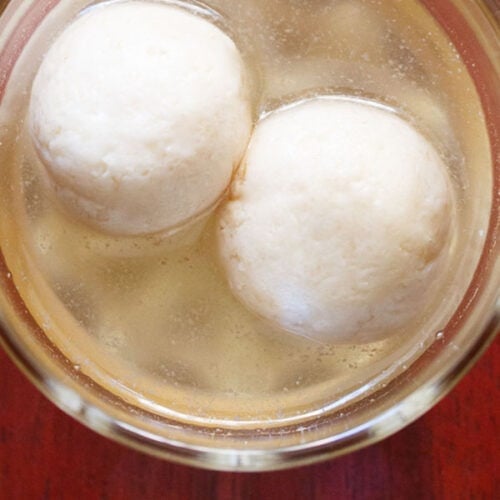
Rasgulla Recipe | How to make Soft Rasgulla
Ingredients
- 1 litre whole milk
- 2 to 3 tablespoons lemon juice or add as required
- 2 cups sugar or raw sugar
- 1 litre water
- 1 tablespoon milk – optional
- 1 teaspoon sooji (rava or cream of wheat) or all purpose flour or cornstarch
- 1 to 2 tablespoon rose water or kewra water or ½ teaspoon cardamom powder
Instructions
Making chenna
- Take milk in a pan and keep it to boil on a low to medium heat.
- I used organic cow milk which does not have much fat. If you use buffalo milk, it has too much of fat and makes a thick layer of malai/cream floating on top. You have to remove the thick layer of malai, before you proceed with the making of chenna.
- So when the milk is heating up, line a strainer or bowl with a cheese cloth or muslin.
- Keep on stirring the milk at intervals so that the froth is not formed on top and the base does not get browned or the milk solids get stuck to the bottom.
- When the milk comes to a boil, then reduce the heat to its lowest. Add 1 to 3 tablespoons lemon juice. First add 1 tablespoon lemon juice and stir. If the milk has not curdled completely, then add 1 tablespoon more. Keep the lemon juice handy with you.
- Depending on the quality of milk, you may need to add 1 to 3 tablespoons of lemon juice. Stir after adding the lemon juice. Sometimes I have added 1 tablespoon lemon juice and the milk has curdled and sometimes I needed to add 3 tablespoons too. Vinegar also can be added instead of lemon juice.
- Another option is curd/yogurt. Add 4 to 5 tablespoons of yogurt or more if required. With yogurt you don't need to rinse the chenna in water later.
- As soon as the milk curdles, switch off the heat. The milk should curdle completely with the green watery whey. If the milk does not curdle, then add ½ to 1 tablespoon of lemon juice more.
- Now pour the curdled milk in the cheese cloth/muslin lined strainer or bowl.
- Gather the muslin from the sides and rinse the chenna or coagulated milk very well in running water. This brings down the temperature of chenna as well as removes the lemony flavor and tangy taste from the chenna.
- Now squeeze the muslin with your hands very well, so that excess water is drained from the chenna. Remember there should not be excess water or moisture in the chenna as then the rasgulla will break when cooking.
- Place a heavy weight on the chenna for 7 to 8 minutes. You can also hang the chenna for about 30 minutes.
Making rasgulla balls
- After 7 to 8 minutes, remove the cheesecloth from the chenna. Note that the chenna should not have too much moisture nor be too dry.
- Add 1 teaspoon sooji or rava or semolina. You can also add all purpose flour (maida). Adding either of them helps to bind the mixture. For a gluten-free option, add cornstarch instead of semolina or all purpose flour.
- First mix the sooji with chenna and then begin to knead.
- With the heels of your palms mash the chenna and knead. Keep on collecting the chenna from the sides and continue to mash and knead.
- This kneading process is very important and also decides the texture of chenna. When you feel your palms becoming a bit greasy, its time to stop. Just a bit of greasiness is required.
- Avoid kneading to an extent where the whole chenna becomes greasy. I kneaded for about 10 minutes as I have very light hands. So depending on the quality of chenna and the pressure you apply while kneading, you can take more or less time. Note that the chenna should just begin to get greasy.
- Knead to a smooth ball of chenna.
- Now pinch small portions from the chenna and roll them between your palms to a smooth round ball.
- Prepare all small balls this way. Cover all the chenna balls with a moist muslin or kitchen towel and keep aside.
Making sugar syrup
- In a large pan, take 2 cups sugar and 4 cups water.
- You have to use a large pot or pan so that there is enough space for the rasgulla to cook and increase in size. You can also use a pressure cooker. I used a pot measuring 8.5 inches in diameter and 4.5 in height – a 3.4 litre stainless steel pot.
- Keep this pan on stovetop and heat the sugar solution. Stir so that the sugar dissolves. I cooked kneaded the chenna and cooked the sugar syrup simultaneously. You can also do this way.
- Add 1 tbsp milk and stir. Adding milk helps in removing impurities. If there are no impurities then you don’t need to add milk and directly proceed to step 6
- Once the sugar solution becomes hot, the impurities begin to float on the top. You can either remove it with a spoon. Or strain the impurities in a cheese cloth/muslin lined strainer.
- Now from the purified sugar solution, reserve ½ cup in a cup or mug. This ½ cup of sugar solution we will be adding to the cooking rasgulla.
- Reserve another 1 cup of the sugar solution in a serving bowl.
Cooking rasgulla
- The rest of the 2.5 cups of sugar solution you add it back to the same large pot and bring it to a boil on a medium high heat.
- Slid the rasgulla gently into the sugar solution.
- Once all the rasgulla have been added to the sugar solution, shake the pot. Don't stir the rasgulla with a spoon. Just gently shake the pot.
- Cover immediately with a lid and let them cook. Keep the heat to a medium or medium high.
- After 4 minutes, open the lid and add ¼ cup of the reserved sugar solution. Shake the pan. Adding this reserved sugar solution ensures that the temperature and consistency of the sugar solution is maintained and the sugar does not cook to its thread consistencies.
- Cover again and continue to cook.
- After 4 minutes, again add ¼ cup of the reserved sugar solution. Cover and again cook for 2 minutes. I cooked for 10 minutes. The timing will vary depending on the thickness & quality of pan, the depth of the pan and heat intensity.
To check the doneness of rasgulla
- There are two ways. First place the rasgulla in a bowl or cup of water. If the rasgulla sinks to the bottom its cooked.
- Second method is to press a small portion of the rasgulla with your finger. If the pressed portion bounces back to its original shape, its cooked
- Once they are cooked, switch off the heat and keep the pan down on the countertop.
Soaking rasgulla in sugar syrup
- Now take each rasgulla with a spoon and place it in the bowl containing the 1 cup of sugar solution. Cover and keep aside.
- Let the sugar solution in which the rasgulla were cooked, become warm. Then add this to the serving bowl containing the rasgulla.
- Once the whole mixture has cooled down, add 1 to 2 tablelsoons rose water.
- If you don't have rose water you can also kewra water (pandanus extract) or ½ tsp cardamom powder. Stir gently and allow them to be soaked in the sugar syrup for 30 minutes.
Serving and Storage Suggestions
- You can serve the rasgulla now or refrigerate them and serve later cold or chilled.
- When serving place the required amount of rasgulla in each serving bowl. Pour a few tablespoons of the sugar syrup in each serving bowl. If you prefer garnish rasgulla with some slivered almonds or pistachios.
- Keep them covered with the sugar syrup in an air-tight container. They keeps well for about a week in the refrigerator. Do not store them at room temperature.
Notes
Nutrition Info (Approximate Values)
This rasgulla recipe from the archives, first published in Jan 2015 has been updated and republished on 30 October 2021.
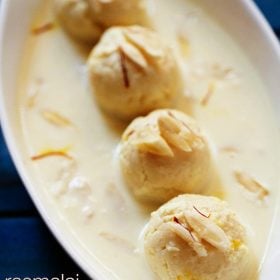

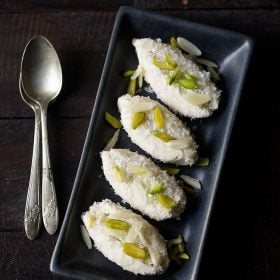
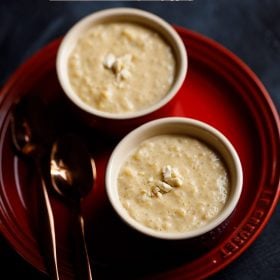








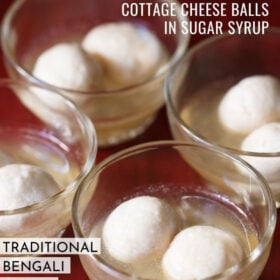
Hi dassana
For the rasgulla recipe can I use 1.5% fat milk available at my region?
Thanking you in advance…
avoid using 1.5% milk. first of all chenna will have a loose texture and rasgulla will disintegrate while cooking.
Can we use pasteurized cow milk.
yes you can.
Hey,
Thanks for amazing and sweet article of Rasgulla Recipe To be honest I never tried this and i’m really excited to make that Hahaha,
Can you please clear my one question here that Is it possible to use persian saffron in it ? If yes then how much please mention the quantity also.
I will be waiting for your reply
Thanks
welcome and thanks. you can add saffron. for persian saffron, you can add 20 to 25 strands in the sugar solution or in the chenna. if adding in chenna, then add saffron strands when you boil the milk. alternatively you can add saffron strands in the kneaded chenna. mix the strands with the kneaded chenna and then form the rasgulla balls.
your recipe is very nice but when i am trying to make ras gulla
every time its break when I make in ball why???/
if there is more moisture in the chenna, then the rasgullas will break. so next time try to keep the weight longer on the chenna so that extra moisture is drained.
My rasgullas had a lemon flavor even though I had washed the cheena twice. Except that all was great.
if you rinse the chenna well, then the lemon juice aroma should not be there. not sure what must have gone wrong.
Hello mam…i really like ur recipes v much..i tried rasgulla recipe..bt they didn’t turn out good..rasgulla were flat and broken…pl tell me what might have gone wrong and what things should be taken care of?
jyoti, if there is more moisture in the chenna mixture then the rasgulla will break. so the water has to be drained well when making chenna. so keep a heavy mortar or pestle on the chenna at least for 7 to 8 minutes before you start shaping rasgullas. when kneading also when you see some fat or greasiness on your palms, then stop kneading and make the rasgulla balls.
Hi Mam I tried today but rasgulla are not spongy it’s like soft or not exact spongy from inside
rimple, if the rasgullas are cooked more then they don’t become spongy or soft. they become hard. this could be the reason that the rasgullas have not turned soft.
Hi! Tried your Rasgulla recipe today. They came out spongy but did not absorb the flavour of sugar syrup nicely. I will try again for sure. I think they were good for a first attempt ????.
All your recipes are just amazing. Cooking was never my cup of tea until I came across Veg Recipes of India! Since then I have tried so many recipes of yours and will keep doing so.
You are too good!
Thanks a lot ????????
Welcome Pooja. Glad to know that you have tried many recipes successfully from the blog. Thanks for sharing this awesome feedback on recipes.
The texture of the rasgulla is nearly smooth on one side but cracked on the other side. What might be wrong? Can you help me out?
fine cracks are fine. large cracks can be due to less moisture or less fat content. also when rolling they have to be rolled well. while kneading a bit of fat should just start releasing and you will fee a bit of greasiness in your palms. at this step you can start making balls. hope this helps.
Thank you sooooo much for this spongy rasgolla recipe. I am a bengalee and know the perfect taste and texture of rasgolla. I tried this last night and it came out perfectly.
Welcome Pradipta. Glad to get a positive comment on rasgulla recipe from someone who knows the real taste and texture of rasgullas.
Hi,I tried to make this and it looked really good while cooking.But as soon as I turned off the stove and transfer the rasgulla in the syrup it flattened out.So no more round.What could be the reason?
for cooking the rasgullas balls, its always better to use a dekchi or a pan which has the same diameter through out and the pan should be large. the cooking is even. also if there is too much of moisture drained out from chenna, the the rasgullas can become flat.
Thanks a lot, u r god u saved me today. How cud u be so pricise. My rasgullas are perfect. Thanks a lot
Welcome Gauri. Thanks for your kind words.
Detailed instructions, very precise!!
Thanks Madhu
I’ve a simple question: Isn’t a good Rasgulla supposed to absorbe a small amount of the sugar syrup it’s dropped in to -just like how a good Gulab Jamun does? My wife says, “No” and I have my own doubt. You’re the expert to settle my dilemma and this is one defeat I can DIGEST with pride! Thanks!
of course the rasgulla has to absorb the sugar syrup. otherwise it won’t be sweet. dilemma settled ????
Hi,the recipe looks simple,I tried with spoiler milk,when I added rasgullas to the syrup after few minutes,they break.Plz tell me what do I do?
renu, for making rasgullas its always better to make with fresh milk. reason being with spoiled milk, the texture of chenna will be different. the rasgullas have not been able to cook well and thus they have broken in the sugar syrup. hope this helps.
I am trying with curd cheese from store. Is it ok and ll not have yoghurt flavour? Pls let me know. Thanks
ramya, rasgulla is best made with fresh chenna. i hope the recipe went well for you with store brought curd cheese.
Hi, i made this rasgullas and it turned out to be really good and spongy, i used a bit of corn flour and semolina both, but nothing effects the end result, i like your website a lot i have learnt and tried so many things from here and all are good and worth trying it, thanks for all your efforts
Thanks Chandni for sharing your positive feedback on rasgullas. Glad to know that you have tried many recipes from the website. Happy cooking.
Only one word Awesome thanks
Welcome Ankita
Thank you Dasaana. Is it okay if i use a rolling pin to mash the chenna? My hands have no strength. Plus i have to make so many at one time. Is there anything i need to watch out for if i mash it with a rolling pin? Thanks in advance!
try mashing with a stone pestle if you have one. i am not sure mashing with rolling pin will give you good results. you can even use a mixer or a grinder. hope this helps.
I tried the recipe, however a couple of things I noticed happened
1. They were a bit too hard.
2. They were also a little chewy.
3. It tasted a little high on the lime and milk water residue while we make chenna.
Can you help me in what could have gone wrong?
anirudh, hard and chewy means that the rasgullas have been cooked much more. another reason would be less moisture in the chenna. usually when the whey is drained, the lemon juice also gets drained with it. after the adding the lemon juice, mix very well. this way the lime or lemon juice is distributed in the milk and also helps in curdling the milk evenly. if the chenna is drained well, then the lemony taste and whey is not felt. hope these suggestions help.
amit, what I meant is it did not soak the sugar syrup. so it was dry inside and not spongy enough.
okay. this has happened as the the sugar syrup has gotten cooked to a string consistency – meaning got cooked too much with half to 1 string consistency. thats why the rasgullas could not soak the syrup. if the syrup becomes sticky with half to one string consistency then the rasgullas won’t be able to soak the syrup.
I made these yesterday but did not turn out perfect. cooked till they sank, but even after soaking overnight, it did not absorb the flavour, and tho spongy it is not translucent like store bought. what do u think went wrong. ? can I fix it now?
sneha, i don’t get what flavor and texture you are exactly looking for. these rasgullas are spongy and so the texture will be spongy. did you flavor the syrup with add rose water or kewra water or cardamom powder?
Hi Dasana, thank you very much for this recipe. I tried it for the first time for my daughter’s birthday. Though it came well, soft and in good shape, it was not spongy after I moved it to the separated sugar syrup. When I removed a ball to check if it’s cooked, it was spongy and sank to the bottom too. But later it wasn’t so spongy. Any suggestions.
nirmala, looks like the rasgullas got overdone. thus the sponginess is not there. for the doneness test, even if the rasgullas are overcooked, they will settle down at the bottom of the water. next time you cook for less time. hope this helps.
Just want to say dassana I love you every time I tried your recipes it’s come out really really good, actually am a northeast girl married to a Rajasthani mharwadi pandit 🙂 after marriage I turn on veg and am trying your recipes and following your recipes my husband loves my veg food and sweets or whatever I made in veg thank you so much…
welcome rina. glad to know i could you help you in cooking veg food. happy cooking.
Hi,
I just tried this recipe. I hung the chenna for 1 hour and then put it under a weight for 3 min. I got 14 balls in 1 litre of milk. The chenna was soft. The balls puffed up (almost double the size of the uncooked balls) in the first 4 min. In the second 4 min, they shrunk, not to their original size, and they flattened out too. (I have used a large heavy bottom aluminium kadhai, in which they had a lot of space to grow.) I checked whether it was done, but it was still floating. I kept for another 1 minute and switched off the gas. Please advise why they shrunk. Thank you!
ishi, for cooking the rasgullas balls, its always better to use a dekchi or a pan which has the same diameter through out. in a kadai, the diameter is less at the base and increases with the height of the kadai. in this case, looks like too much of moisture has been drained out from chenna. one hour is a long time. 30 minutes is fine. after keeping chenna hanging for 1 hours, there was no need to keep it under a weight. also i think the flattening here is due to using kadai. the space should be even throughout cooking. next time you can just keep the chenna hanging for 30 minutes or follow the method of keeping a weight as mentioned in the recipe. also use a large thick bottomed pan or dekchi to cook the rasgullas. hope these suggestions help.
very nice and very perfect recipe
thanks trupti.
I tried the rasgulla recipe. But the rasgulla did not sink to the bottom even after cooking for 40 minutes and then they became hard. What went wrong ?
hasrhita, 40 minutes is a very long time for the rasgullas to cook. they will become hard. just cook for 8 to 10 minutes. the testing is done in a separate bowl or glass with fresh water. also you can press a small portion of the rasgulla with your fingers. if it bounces back and regains its shape, the rasgulla is cooked.
Wow very good
thanks.
Hi Dassana!
Do you know how to make rasgullas out of milk powder?
deepti, i have never tried making rasgullas with milk powder. i always make them with milk.
HI , i try to made rasgulla, i don’t know even i completed all steps but i found rasgulla internally didn’t cooked and remain kacha
okay. looks like the rasgullas have not cooked well. you can add them back in the pan and cook for a couple of minutes.
Hi I like ur recipes.all are easy to cook.
thanks tajinder.
Thanks for the great recipe. Your tips were very helpful. I just finished making rasagullas using your recipe. I’ve made them before, but your recipe gave me the most soft and tasty rasagullas. Especially the tip to check when the rasagullas are cooked made it perfect. Thanks again!!!
thats great to know saradha. thanks for this lovely feedback on the rasgulla recipe.
Hi… a question… Can I use store bought paneer to make this?
avoid using store brought paneer. the rasgullas might become dense or hard.
We tried the rasgula but it didnt turn out spongy. what went wrong?
can you let me know what the things that went wrong, so that i can find the cause of it.
Hello Mam
I love your all recipes . I made rasgulla by your recipe, they were awesome and better than market rasgulla.My husband ask me to made it again .A lots of thanks for you. Please tell us the procedure of non spongy rasgulla.
With regards
thats nice to know ruby and thanks for the positive review on rasgulla recipe. i will try to add the non spongy recipe of rasgulla too.
Hi. I tried this recipe and my rasgulla turned out so fab that I couldN even imagine them to be so.
But I wanna make now spongy ones whicvare made without corn flour. Now I have searched so many recipes, tried three of them .and have failed each time. Sigh|! So please help me. By guiding me some way or posting a recipe for that. Cause I really really want to make them. You could also answer to this post by saying yes or no to my following questions.
1. Can I make the spongy rasgulla recipe by applying the same method that you used for this corn flour rasgulla? Only just emitting the corn flour step. (If you answer yes to this question then you need not reply to further questions but if answer is no then)
2. Should I omit the corn flour step and the steps wherein I have to add water during the boiling of rasgulla.
3. Should I ue the same amount of water and suger ?
Thank you. I would really grateful if you would reply ti my post accordingly.
thanks nidhi. these are also spongy rasgullas 🙂
1. yes you can use this method. you can even skip adding corn flour.
if any other questions, then feel free to ask.
thanks for the inputs amit..let me try it again
welcome shree.
Thanks for the recipe.
Can I reuse the sugar syrup to make more rasgullas?
welcome prachi. you can reuse the sugar syrup. but if required you may need to add more water and some sugar in this syrup, so that while cooking thread consistency is not formed in the syrup.
my rasgulla’s are soft and tastes good…I have a question..I prepared sixteen rasgulla’s with one liter milk..but they are not in perfect round shape after cooking. the look flat like doodh peta..and the size of the rasgulla is not double the size actual uncooked one..I cooked in six and half liter handi ..suggest me what are the tips to make round medium lemon size rasgulla..and what if I want to make more rasgullas with about two liters of milk.since my handi is big and sugar syrup is more ..can I use the same measurements as one liter milk and two cups of sugar ..
shree, the pan or pot has to be slightly broader and deep as well. rasgullas need some space while cooking as they expand. if there is not enough space, then the become flat. you have used a big handi, thus the sugar syrup is not having enough volume in the handi. it will settle down. 1 litre water in 6.5 litres handi will make that 1 litre water settle down. i am trying my best to explain. the water level should at least be half of the handi. so the rasgullas are having space but not completely dunked or immersed in water. try using a 3 to 4 litre handi. for 2 litres of milk, you can 6 to 6.5 litres handi and increase the amount of the other ingredients also proportionately. more water is required, so you will need to increase the water as well as the sugar ratio. otherwise the rasgullas won’t be sweet.
I made rasgullas today but they came out very hard.. Why does this happen?
rasgullas become hard if they have been cooked too much or the chenna is not kneaded well or if the chenna is dry. so could be any of these reasons.
Hi Dassana. The recipe looks great and I want to try it out, but I am worried about what to do with all the leftover syrup. Any suggestions?
thanks priya. you can make nimbu pani (lemonade). you can also add it to shikanjvi or fruit juices or while making cakes.
Very yummmmmy very nice
thank you jeba 🙂
hi thnx for the recipie ….. i tried this recipie but got hard rasgullas ….why?? plz give some suggestions thnx
either the rasgullas were cooked too much or the chenna has little moisture. could be any of this reason.
I get good soft rasgullas but shape isn’t forming at all.. All times they flatten out but very soft & tasty..
I followed the instructions to the ‘T’ all times . I Hv tried several times…,
Please give me sm tips
okay. they flatten as you need to give them enough space when cooking, as they expand while cooking. so use a large pan. also the syrup should not be thick. i hope these tips help.
I made as mentioned above…but they are not that soft as rasgullas used to be…what can I do to make it more soft??
looks like the rasgulla have been cooked too much. once they become dense, then they cannot be made soft. i am afraid, nothing can be done.
Hello mam, I have tried numerous recipes yours and all of them have proved to be amazing. your step by step pictured details are of great help. Thank you so much for sharing and helping us become good cooks 🙂
thanks a lot saher. nice to read your comment and happy cooking 🙂
so nice
For sugar syrups can we use organic brown sugar
i have never made any sugar syrup with brown sugar. so i have no clue how the sugar syrup turns out. you will have to give a try.
Hi ,
Dunno why my first comment wasnt posted .. Anyway great representation of the recipe . I so wanted my rasagullas to come out like yours so followed your exact recipe but it didn’t ? . Softness wise they were v good but they didn’t puff alot . While i was cooking , the rasagullas were in good shape but as i removed the lid ,they shrunk and they had been like that even after putting in sugar syrup. Rest everything seemed fine . Could you please tell what could be the reason ?
Thanks
monica, we did not receive your first comment. as you mention. they will shrink, if they have been cooked more. then placing them in sugar syrup also won’t help. otherwise i have no clue what must have went wrong.
Hey ,
Actually they shrunk even when they were not cooked. I opened lid after 10 minutes (with between breaks as per your recipe) to do the water test but they were floating so i kept for 2 more minutes.. Unfortunately they remained shrunk . Really dont know what went wrong . But i will try your recipe again..??
okay. then could be due to the chenna having less moisture or its quality. next time you can keep the weight on chenna for less minutes than what is mentioned in the recipe. happy cooking next time.
Hello….
I just love all ur recipes….!! They r awesome.!
I have tried many of them. In this recipe my rasagullas became little firm in consistency n a bit sticky to teeth. Means not spongy… Juice was not one thread. Can u give me idea where I might have gone wrong?
thanks prachi. since you mention the rasgullas were sticky, it means that the sugar syrup was cooked more. the sugar syrup should not be even half thread. when the thread consistencies happen, the sugar syrup become sticky and due to this the rasgullas cannot absorb the syrup. hence they don’t become soft and spongy. next time cook the syrup as well as the rasgullas for less time.
Thank you didi! I am visiting my relatives for Christmas, this will be an awesome sweet meat for them!
surely manju try them 🙂 and you are welcome always.
i am huge fan of veg recipes of india. any dish i want to try the first website i go to is this. but I tried the rasagulla recipe for the first time it didnt turn out so well.i have another easy recipe for rasagulla that take only half an hr but turns out extremely soft and spongy. can i post it
thanks charulatha. the texture of rasgulla depends on the texture of chenna, the moisture content, the cooking time and the pan size also. you can share the recipe. you can send me the recipe to vegrecipesofindia(AT)gmail(DOT)com. i will first try the recipe and then add. if you want you can also post the method in the comment section.
Please post your recipe in comment box
hello ma’am can i blend the chenna instead of kneading it…n how many rasgullas doest it make from one litre…otherwise ur recipe is great…
sakina you would have to knead the chenna and not blend for better results. also the quantity would depend on the size and shape of rsagullas. hope this help’s you 🙂
Thank you ma’am for this wonderful recipe! It was my first attempt and the rasgullas came out really well thanks to your detailed tips! ?
Your recipes and the explanations with pictures are awesome. Keep sharing them for amateurs like me. I have developed interest and learnt a lot of cooking through these posts. Thanks again. ?
pleased to know this bhagyashree 🙂 thankyou for your positive words welcome always.
Madam, Namasthe. I followed the steps mentioned above by you. But, the chenna balls got broken and completedly mixed/broken with the boiling sugar syrup. once again I tried it with the paneer brought from a govt dairy and this time too all the balls either broken into pieces or got completely mixed ilke kheer in the boiling sugar syrup. pl advise me.
namaste jayalakshmi. if the moisture is too much in the chenna, than the balls disintegrate in the water while boiling. i would suggest you to make fresh chenna at home and keep it under the weight for 15 to 20 minutes.
Thank you for the recipe. .It came out very well…but I didn’t mix any flour or Rava to it…I have sugar syrup leftover…what can I do with it?
welcome swechha. you can make nimbu pani with the syrup. you can also add the syrup while making sweets like sooji halwa/sheera, kheer or in cakes too.
Thank u very much. .Will try it…I follow ur recipes. ..its like opening a fridge daily and looking what should I do 😉
welcome swechha and thanks again.
Osm receipe Amitji.
I did the step by step procedure and was successful.
What else can be added instead of rawa or suji to make it edible in fasts…
Also how white colour can be der of rasgullas.
As des had a golden touch !
thanks meenakshi. you can skip the rawa or sooji altogether. or you can also add arrow root flour for making in navratri. only arrow root flour will work. other flours used during navratri will give their taste and flavor. the golden color is due to the color of the sugar used.
Dear dassana ji,
We tried rasgulla it came out very well thanks for the recipe. When ever i make any item i refer your site only.Thanks once again
Madhavi
thanks a lot madhavi 🙂
Hi dasaana I tried the raasgulla’s today n they were good soft n spongy but not sweet as the radsgulla to b what to do n after cooking i did the water test that also good but when the raasgulla are cooled they became hard and in taste they were not swt
i think the rasgullas did not absorb the sugar syrup well. either the rasgullas were slightly dense or the sugar syrup must have got thickened. it needs to have a watery consistency throughout. also due the rasgullas not absorbing the sugar syrup, they became hard after cooling.
please help me in making rasgullas.i make rasgullas but many quantity of Ararat powder the rasgulla is hard .then how to improve it .please send me now.
you mean arrowroot powder. may be the chenna is having less moisture or you are kneading too much. this could be the reason that the rasgullas are hard.
U gave detailed recipe of rasugulla…………..superb 1
Hi Dassana,
Just love your website and recipes. Looks yum yet very easy. I am working mommy and fond of cooking. My husband and both the kids are foodies too. We are North Indians and settled in Bangalore now. I crave for sweets so keep trying them at home. Was trying to find out Jalebi recipe, could not find it. Can you please help me to make Jalebi?
thanks nutan for sharing positive feedback. glad to know this. i am still trying to perfect jalebi recipe. will try to post it soon.
prepared it everything was good like spongy n not chewy n good white colour bt it was not fluffy as much it should be I mean the holes we see in ur pic I dintget such nice texture inside, can you suggest something for improvement of texture ?
mash and knead well. also cook for a shorter period of time.
Thanks raj and dassana. …got answer from u r conversation. …going to try this….
welcome chhavi
Hi
I have tried this rasgulla recipe couple of times and every time the results were good , my query is that sugar syrup which I made to cook rasgulla is accumulated, can it be reused or suggest some recipes in which I can use this.
Thanks for the awesome rasgulla recipe, I’m making it regularly now as my son loves it….
Thank you chhavi. The sugar syrup can be used to make drinks or coolers.
hello! this was my first recipe from your blog. The rasgullas did sink to the bottom of the water bowl however when I let all the rasgullas cool they were not spongy. Please help me..
when the rasgullas are not spongy, this means that they have been cooked too much. even over cooked rasgullas will sink at the bottom in a water mug or glass. so i think less cooking time was needed. the cooking time varies with the quality, type, size and thickness of pan along with the flame intensity. even after 5 minutes, you can check to see if the rasgullas are cooked or not in the glass or mug of water.
thanks alot for ur help.. And this blog is really amazing and the way each step has been explained with diff alternatives of the ingredients takes it to another level compared to others. Thanks again! 🙂
welcome tarana. thanks for sharing positive feedback.
Hey! I tried making rasgullas today but while on flame my rasgullas broke .they were soft enough that I couldn’t even pick them up with a spoon .
Was it beacause i kneaded the chenna more than required ?
when rasgullas break, it means the chenna is too moist. too much moisture will break the rasgullas when cooking. also the kneading should not be done too much.
Can we place the rasgullas in the refrigerator as soon as they are separated from the hot pan?
no. allow them to come at room temperature and then keep in the fridge.
Awesome recipe and very easy to make thanks for such gud recipes
welcome nidhi
I tried this. Awesome taste. Thanks.
welcome chandan
Hi,I have tried this recipe today,thanks for your guidance,its very yummy and tasty ,but after slid into sugar syrup,the balls has been changed in colour and while twisting the vessel it was broken,what’s the problem? I have prepared with cow milk……..
you can prepare with cow’s milk or buffalo’s milk. the color change is due to the color of the sugar. they rasgullas broke as there must be a lot of moisture in them. again the pan has to be large. if they come in contact with each other or if the pan is shaken heavily, they will break.
Thank you for such a detailed recipe. I have not tried this recipe but your abundant detail has given me much confidence. You are a good teacher.
welcome christina. nice to know this.
Hey i tried dis recipe yesterday 2 nd time,but it doesnt came out so sponge like store bought..i followed d same procedure of yours…but dont know wat d problem…may b i knead d dough too much..is dis may any reason for not so successful attempt?
could be that the rasgullas got cooked too much. also can be possible that the chenna did not have enough moisture in it. another reason could be too much of kneading.
Can I make it from toned milk ?
pipli, you can try but i am not sure.
The receipe was really gud…. I followed each step as shown and the recipe did come very well… usually my 1st time deserts are never success…yippeee.. thanku very much
welcome prachi. glad to know this. thanks for sharing positive feedback.
Thank you so much.
welcome adakhan
Very nice recipe.. I tried it for the first time and it came soooo weel.
Thank you so much.
welcome kayal. glad to know this.
Hi dassana
I made soft regullas with ur recipe today.it just melted in mouth.
I have tried this recipe before 4 times with nandini full cream milk but every time it was a failure.So today I tried with heritage milk and it came out too soft.which is good but if I want little dense regulla like haldirsms what should I do?
try cooking for a few more minutes. meaning over cook them a bit. not much. after the water test is done. just cook them more for a minute or two.
Hiiiiii Dassan,
I’m really glad to have this easy rasgulla recipe,
Thanks from all my family members to share your recipe. Thank you once again.
welcome umme. glad to receive such a positive feedback. thanks.
hi dassana
once again thanks for such n easy recipe….. n know what it came out perfect 1st tym wen i made it 🙂
welcome mehjabeen. glad to know this.
Thanks for the recipe, I succeeded in 4 attempts 🙂 Can’t believe I can make perfect Rasgullas now!
Sharing my failures and tips. All 4 attempts were made with most commonly available Nandini toned milk, in Bangalore, which has 3% fat and 8.5% SNF. The first time I made it, followed the recipe completely, I got 11 pieces, figure I squeezed it too hard. Rasgullas did not puff as much and were hard with raw paneer taste even after cooking for 20 minutes.
Second time boiled milk refrigerated and removed Malai (cream from top) made chenna, squeezed less got a couple of rasgullas extra lighter but chewy. Spongy texture.
Third time no skimming of milk before making chenna, but gently squeezed the chenna, hung it for 10 minutes. I weighed the chenna: 150 gms, mashed for 5 minutes, got 16 Rasgullas , came out well.
4th time I did not squeeze the chenna , just washed and hung it for 10 minutes, weighed it was 170 gms, made 16 bigger pieces, boiled in WATER for 12 minutes, soked in refrigerated syrup from previous lot with a cup of boiled, cooled water added. These were the best, a delight, softer than I have eaten anywhere. I am sticking to this recipe.
I guess if you need Spongy, chewy- KC Das type rasgullas, use leaner milk or remove the cream after boiling and freezing.
super and wow. it takes a lot of effort, patience and practice to keep on bettering or perfecting any recipe. thanks for sharing your helpful tips and suggestions to the readers. as you say, the cream or malai has to be removed. otherwise the too much fat does not allow the rasgullas to become spongy. thanks once again for this detailed comment.
I made the rasgullas the same way.. Did not squeeze chenna too much.. Used milk after removing the cream .. The chenna was quite grainy.. The balls turned out OK.. Although a little course.. But the rasgullas had raw paneer taste. Don’t know where I went wrong.
the chenna needed to be mashed more to remove the grainy texture. the texture of the chenna balls should be smooth. could be due to this you must have got the paneer taste.
The website and all the recipes along with procedures captured in video and photos looking excellent. I am really wowed!!! to see all the recipes!! Good work !! Very happy on seeing this site and I tried many new dishes which have been mentioned with procedures here. Awesome!!!
thanks sindhu for sharing this positive and encouraging feedback on recipes.
can u please say me wat measurements hav to take for 500ml mlk.. for sugar syrup..
just halve everything proportionally. for sugar syrup, take 1 cup sugar + 2 cups water.
Hello…. i also tried ur rasgulla recepie bt aftr keeping it in refrigerator it become hard. Can u suggest me whats d problem???
neha, probably the rasgullas got cooked too much thats why they became hard on refrigeration. when you refrigerate the rasgullas, then bit of softness goes away but not too much. they still remain spongy.
I followed your recipe and made super soft pieces of heaven! Everyone at home loved them 🙂 Thank you for putting it down in words with supporting pictures. The pictures make it especially easy to gauge the texture of the chena while kneading.
welcome sneha. glad to know this. thanks for sharing your encouraging feedback on rasgulla recipe.
Hi, I tried this today… Everything was good but the rasgulas turned out to be dense n creamy in texture and did not soak the syrup very well. What could be the reason? PS the chenna was made in the morning, was resting all day and I made the rasgula in the evening.
as soon as the chenna is made, the the rasgullas need to be made asap. chenna should not be allowed to rest. could be due to this reason that the texture was dense.
Very nice recipe.tried today for the first time using regular milk and came out very nicely.soft n juicy just like once we have from sweet shop.great job.thanks a lot dear.
welcome amita. glad to know this. thanks for sharing positive feedback.
Hey Dassana,
This recipe is awesome! I tried it yesterday and it worked out just perfect. I’m from Bulgaria and I’ve never tried anything like it. It was a bit odd and unusual first when I tried it, I’m sure you know how it is when you taste things that have nothing to do with what you’ve eaten so far :))) The bottom line is – I love it! And I love your blog, it’s my newest inspiration! I can’t wait to cook a million things from it. :))))) <3
thanks russalia for sharing positive feedback. yes i can understand. do try some more recipes.
Hello Dassana,
Tried the recipe today, guess I added a bit too much of dough while kneeding. Its tasting a bit raw. I checked if its cooked as suggested.
Married a year ago, dint know most of the ingredients needed while cooking. This website has come to my rescue several times. Even learned how to make chai from here. Although just mastered chapathi dough still a long way to go.
Thank you for the help.
welcome kripali. glad to know this. i didn’t understood your question about rasgulla.
No question. Being the first trial on this receipe I made the rasgullas with a very small quantity of milk. Dint get the right measurements after that. Will try it again someday. Thank u.
welcome kripali
This process is very good.
Hi dassana. i followed all your recipes.. I had tried to make rasagullas several times before. But it never came out. Today by chance I got ur recipe. Made it today. Don’t know what went wrong at the end rasgullas should be soft and juicy after they are dipped in sugary syrupbut they were hard..rubber like.
plz help me…
the hardness is due to either over cooking or the moisture was less in the chenna.
What perfect rasgullas, I just finish making rasgulla with your recipe
Dassana ji you are really my Guru.I made so many veg items after going
your web page.Everybody in my family are suprised how could make all
this. Thank you Dassanaji
welcome rajan. glad to know this. thanks for sharing your positive feedback on rasgullas.
Hi Dassana,
Thank you so so so much for this recipe. I come from a family that cooks A LOT and for some reason, this was one thing we were never able to perfect. This one is for the books!
Thank you again for the amazing share.
Regards,
Shivani
welcome shivani. glad to know this. your feedback matters a lot specially because its coming from a experienced home chef like you.
Hi I tried your recipe but something went wrong, the rasgullas started floating while cooking, I left them in for a little longer but as I tried to take them out, they broke up and melted away.
while cooking, the rasgullas float 🙂 they are lighter than the water and hence they float. when they get cooked, they will sink in water at room temperature. this means they get heavier when cooked. the rasgullas melted as there was too much moisture in the chenna.
hi dassana thanks for yummy recipes .i made rasgullas but its have been hard after adding in sugar solution.why?plz tell me that how many minuts should on the flame for sugar solution .
hard could be that the rasgullas got cooked too much or the chenna has less moisture. i cooked for 10 minutes. depending on the thickness of the pan and the intensity or source of the flame, you may take less or more time. after 7 to 8 minutes, you can do the water test and see if the rasgullas are cooked or not. the sugar solution has to come to a boil, before you add rasgullas. i have not measured the time here.
Dassana hi! tryd the rasgulla turned out very good…finally a sucess…thks a lot. I used whole fat packet milk as organic milk ws not avilable.
welcome mohini. glad to know this.
thanks for the feedback mohini and good to know. even regular packet milk works. organic milk is not available everywhere in india.
Perrrrfect! Rasgullag it came out just great! Thank you for this recipe! :))
welcome san
My favorite sweet. Thanks for this great method. I tried it out and my family loved it. I used without lactating cow’s milk. Thank u once again…
welcome divya. good to know this.
Hi dassana. I m new to your site. I had tried to make rasagullas several times before. But it never came out. Today by chance I got ur recipe. Made it today. Don’t know what went wrong. The quality of milk was good. I have to knead only 4-5mints nd my Palm became greasy. Followed each n every step but although rasagullas are soft but it became flat nd doesn’t look like one’s sold in shop. Plz help.I have cooked it for 10 mints but it look uncooked from inside.
hi rabia. try cooking for some more minutes if you can. did you do the water test for the rasgullas to see if they were cooked or not.
I made rasgula.test,texture everything is perfect except shape.where is fault in my rasgulla.wo size me fule hi nhi.just little bit increase in size but not like rasgulla
pallavi, possibly the issue must be with the kneading of chenna.
Hello,
This recipe ws vry simple n my rasgullas came out perfect until i put them in cold syrup kept in serving bowl; after which they turned flat (more lyk rasmalai) and reduced in size. Wt went wrong?! Any sugestions for better ones till the end !!
was the syrup too cold. possibly this could be the reason they went flat. the syrup should be warm or at room temperature.
No it ws at room temp only.
ekata, then may be the chenna was not kneaded well. give one more try.
hi thanks for sharing the recipe. I tried but my rasgullas didn’t swell. Also they left alot of fat which floated on the sugar syrup nd had solidified on the sides when refrigerated. could u help …
thanks nd regards
thats because the fat should have been removed when preparing the chenna. its due to the too much fat that the rasgullas did not swell.
Hi
I m getting curious to c u.this recipe turned out perfect as usual.
Thanks dear.
welcome vasanti. glad to know this.
hi…easy reciepe of yours..i made rasgullas but they turned out to b hard … what to do??
let me know in which step.
at the end rasgullas should be soft and juicy after they are dipped in sugary syrup
but they were hard..rubber like..
okay alia. did you do the doneness test. i think they have got overcooked. thats why they became hard. another reason would be there must not be enough moisture in the chenna.
Thanks for the lovely recipe… The shape and size was perfect… But I encountered one problem was that when I tasted it it was little heavy..I followed every procedure… Otherwise it would have been perfect… Thank you dear
welcome ankita. by heavy you mean the rasgullas were dense or very filling. if they were dense then it is probably because the chenna was over kneaded.
Another perfect recipe with perfect results. Loved it n I can’t thank u enuf 🙂
welcome richa. thanks for sharing your awesome feedback on rasgulla.
Thanx for sharing step by step recipe… Perfect for any beginner as well… Will make it soon…
welcome gunjan. thanks for sharing your positive feedback.
Tried this sweet..a family favourite.
All thanks to ur trial and error method that we got a fool proof solution to make this yummy dish!
Got over in an instant and all I was left with is sugar syrup 🙂
thats great to know nivedita. most welcome 🙂
Your rasgullas have come out beautifully! Thanks for the much-needed detail on how much to knead.
In Bengal, they also make a jaggery-based version of rasgullas, light-brown and delicious. Would you know what substitutions to make for that?
thanks. i know about this version, but never made them. so cannot say what will be the substitutions.
Hi Dassana, Thank you for the recipe. The rasgullas’ taste and texture were perfect. But when I refrigerated the left overs their texture changed a bit. Do you have any suggestions on storing them if I want to make ahead for a party?
welcome preeti. some change will be there in the texture, but they will be soft. if you live in a cold country or climate, then you can keep them out for a day. i don’t think they will get spoilt. but in a country like india, they have to be kept in the refrigerator. they stay good for about a week. so you can plan accordingly and make them a few days before. the recipe can be doubled or tripled. but instead of kneading the chenna with hands, i would suggest to run it in the pulse mode of the mixer or blender.
Dassana…..one quick question, what can be done with the leftover syrup?? The rasgullas finished off in a jiffy and I am left with almost a ltr of sugar syrup!!
thanks ramya. you can make nimbu pani (lemonade). you can also add it to shikanjvi or fruit juices or while making cakes.
Dassana…..I can’t thank u enough for this recipe. I must have wasted lts of milk trying to get the perfect rasgulla. I tried ur recipe this morning and followed it to the t and the result is absolutely fabulous… The rasgullas have the perfect texture and taste. Wow I am so glad I did it…..thx again for the foolproof recipe.
welcome ramya. i can understand because it has happened with me also. glad to know that this recipe turned out fool proof.
Yes I Can !
Definitely Very Soon I Will Share My Experience With You.
These rasgullas r our family favourite….. .vl surely try…and gv this mouthwatering surprise to all of them
thanks pooja. do give it a try and surprise your family.
Waow..i never knew making rasugallas is so easy….
thanks anamika
please add rajasthani daal kachori recipe
jagu, i have added daal kachori in requested recipes list.
Thks Dassana for the recipe! Just a question, after the rasgullas r cooked wht shld b the temp of the sugar syrup (1cup) in which it is put.
welcome mohini. i didn’t measure the temperature. it can be warm or at room temperature.
I cant believe that we can cook rasgullas in such a simple way. You are awesome 😀
thanks abhiruchi for sharing this sweet feedback.
Looks good 🙂 Thanks for sharing 🙂
welcome sabitha
Finally I found the easiest way to make my fav rasgullas!! Pls do add the ras malai recipe if possible.
Making it this weekend! 🙂
thanks nivedita. i will add rasmalai also soon. do share the feedback. happy cooking 🙂
Very nice rasgulla… I made today…. It came perfect… Your recipes are very good… With full of flavour…Please keep on posting more…. Thank you….
welcome ankita. good to know. thanks for sharing positive feedback.
hi dassana… first of all i would like to say… i am a huge fan of yours… till date i have tried max recipes of yours… the best part of your recipe is that all are very easy to prepare… i was never into cooking… but started because of ur simple and delicious recipes.. Thank u very much
I love rasgulla a lot… and tried this recipe as well… however my rasgullas dint become sweet… could you please help me with this….? 🙁
thank you prachi. the rasgullas have not absorbed the sugar syrup and thus they are not sweet. either the rasgullas were dense and got over cooked or the sugar syrup became too thick.
Hi,
I followed all the steps that you have mentioned but the rasgulla were hard and not that sweet as should be.
Please respond
shefali, two things have happened. either the rasgulla have got overcooked and hence become dense or the sugar syrup has cooked into a string consistency and thus the rasgullas have not been able to soak the sugar syrup. just cook the rasgulla for 5 minutes and then check for their doneness. the sugar syrup has to thin through out and should not form even a half string consistency. you can also add some water, if you feel the sugar syrup is becoming thick.
Thanks for detailed recipe. I am going to try this on weekend. I am following your blog since last two months especially for vegetable curries and Indian snacks. Dudhi halwa also turned out to be very tasty with simple ingredients. This blog is indeed a great help for amateur cook like me! Thanks a lot.
welcome monica. glad to know this. thanks for sharing your positive feedback on recipes.